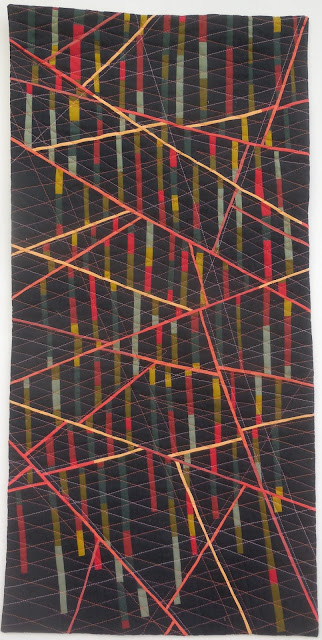Once upon a time I went to another city to teach a workshop. The topic was improvisational strip piecing. People were asked to bring three yards of Kona cotton solids in colors they thought would go well together: one light, one medium, one dark. The agenda was to construct five or six strip-pieced panels, then cut them apart and arrange the pieces into a composition.
As people unpacked their stuff and set up their machines, I walked around the room to get acquainted and noticed that several of them didn't bring the Kona called for in the directions. I commented on this.
One person said, "I have literally thousands of dollars worth of other fabrics in my house and I'll be damned if I was going to go buy three yards more for this workshop."
One person said, "I bought my fabric before the directions got changed." I noted that the directions had been posted wrong, and the minute people noticed the mistake they fixed it. The bad directions had only been online for five hours, and that was four months ago. "Well, that's when I bought my fabric."
One person announced, "I have a really bad attitude today." Why is that? "Because I absolutely hate Kona." Why is that? "It frays in the wash, it's flimsy, it comes apart, I have LIKE A WHOLE GARBAGE CAN FULL OF THESE NASTY THREADS -- I HATE IT!!!" She made her feelings clear by picking up her fabric and slamming it down on the table.
We started to cut and sew on the panels. The panels were to be 21 or 22 inches long (half the width of the fabric; we cut through the fold at the beginning of the workshop) and about 13 inches wide. Each panel had its own "recipe," written on the direction sheet.
As I walked around the room an hour later I saw one panel that was about 10 inches long, not 21. What's happening here? "Don't ask," she said. I was supportive. Not to worry, you'll just have a little less of this color combination when you make your composition.
A while later I came by
again and noticed that her second panel was 21 inches long, but had a big
horizontal seam through the center of one strip. What happened here? "Don't
ask," she said. I was supportive. I sliced it apart horizontally, got rid
of the seam, and said it would be just fine, she was going to slice it
anyway after lunch.
The next time I came by I noticed that her third
panel was full of lumps. I had previously announced that there was only one
thing I was picky about and that was pressing; that if I taught them nothing
else today it would be how to press their piecing as they worked. I told
her this panel wasn't pressed well enough; did she need another demo?
"Don't ask," she said. I said, "I'm not asking; I'm telling you to press it
again." She sulked.
The guild had appointed a classroom assistant for me,
and I asked her to do two things: bring me a sandwich at lunchtime, and
learn how I wanted things pressed so she could teach people if I wasn't
available. It became apparent that she had larger ambitions. Instead of
just showing people how to press their first panel, and watching to make
sure they did their second one right, she was helpfully doing the pressing
for them.
I kidded her for being an enabler, and told her people had to
learn to do their own unless she was planning to move in with them and press
all their work forever. She promised to stop. But that left her with time
on her hands. Hold that thought.
The fourth panel was supposed to have a neutral color
in addition to the three colors people had brought. They were to choose a
neutral from the big pile of browns and grays I had brought. Many people
asked me for help in choosing the color, but some moved ahead without me.
As I discovered, some were "helped" by my assistant.
I came by one
person's wall and saw that she had four finished panels but no neutral in
sight. What is your neutral color? She thought about that for a while and
finally said, "Green?" Well, green isn't a neutral. This was news. My
assistant had helped her choose it. "We thought that green looked really
nice," the assistant helpfully explained, hovering about.
As the afternoon wore on, I came by and saw that one person's
"13 inch wide" panels looked awfully wide -- I measured one at 20 inches.
What happened here? "Oh, I guess I didn't know they were supposed to be 13
inches." It says so right here on the directions. "Oh, I didn't look at
that sheet, I guess I should have."
One person hadn't made a single
slice into her panels or attempted to arrange them into a composition.
What's happening here? "I never finish things I do in workshops," she
explained. Hmmm. We still have an hour -- you've done all the hard work of
sewing these panels together, and you haven't done any of the fun stuff
yet! Maybe you'd be pleasantly surprised. Well, no. At the final walkabout, when each
person talked a bit about her composition, she gave a user testimonial about the brand of fabric she had brought and
why it was better than Kona.
As I drove home, I worried about this
workshop. I was sorry that the people who hadn't brought Kona couldn't
contribute their strips to the community swap pile, and that if they took
from the pile the fabrics wouldn't sew up well together. I was glad that some
of the people who were following directions, doing good work and having fun
were in one corner together, so they could reinforce one another's positive
attitude. I was glad that Don't Ask had a table to herself. I hoped that
the people who had been "helped" by the volunteer hadn't been too
confused, or lost too much time on wrong turns. Most of all, I
wondered whether I had been able to keep the people who seemed determined to
have a bad time from passing their negativity to the others.

Fortunately, most workshops aren't anything like this one. I'll be teaching the same subject -- Improvisational Strip Piecing -- at Quilting by the Lake next summer, except in a two-day format instead of a single day, so there will be lots more time to sew and lots more time to compose. Maybe I'll have the pleasure of seeing some of my blog readers there!
For more info on the QBL workshops, click
HERE.














































